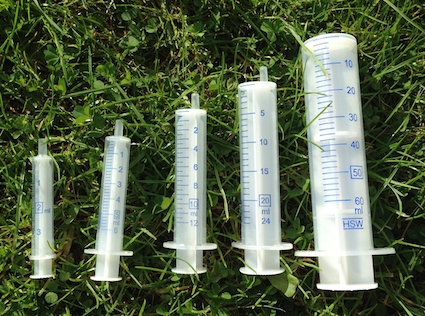
I’ve always used syringes for water play, mark making, as air pumps in technology projects and for having fun in the snow. I’ve always chosen the biggest syringes I could find – 100ml ones.
But this set, a present from a friend, fuelled the mathematical fire within me. Have a close look at the sizes and see what you notice – this is just the sort of thing to ask older primary aged children. Can you see:
- The sizes of the syringes, as well as increasing in capacity, are mathematically linked.
- The numbers printed in the squares allow you to quickly measure a smaller quantity than the total volume of liquid possible. Why do you think this is the situation?
- The three biggest syringes (10, 20 & 50ml) are all multiples of the smallest two (2 & 5ml).
- The capacity of the syringes are all multiples of 3 – 3, 6, 12, 24 and 60ml. Again this allows for lots of quick mental calculations.
The syringes provide further learning opportunities:
1. Can you accurately use the syringe to measure the correct volume of water?
Show children how to fill the syringes to precisely the correct amount, using the printed scale and how to remove the air bubble.
2. Is there a relationship between the capacity of the syringe and the distance you can squirt water?
How could you set up a fair test to measure this?
3. Does the capacity of a syringe affect the splat it makes on the ground?
Or is this dependent upon ground surface and inclination and height or angle at which the water is squirted onto the ground?
4. What is the longest continuous line you can make with a syringe?
This challenge is surprisingly tricky. Your class will needed to develop skill of using a syringe accurately to create a continuous line. Then there is the task of measuring the length of the line. This is also a good opportunity to practice conversions between metres and centimetres. Be aware that the lines can be surprisingly long, even from a syringe with a small capacity. The length of the line made is linked to the volume of water held by a syringe as it’s about conservation of volume. However the children will need to practice and then come up with a fair test.
5. What is the best syringe strategy for a water fight?
For example, if you could choose between having 1 x 60ml syringe owned by one person or having 20 people on your team, all with 3ml syringes, which side is most likely to win? You will have to agree a set of rules for winning the fight and also what behaviours are acceptable or not. Is there a particular combination of syringes for the best chance of wining?
6. Finally, it is also worth considering a conversation about the medical uses and purposes of a syringe. A discussion may also be needed about what to do if you find a syringe that has been left as litter on the ground.
This blog post was originally published in November 2017.





























